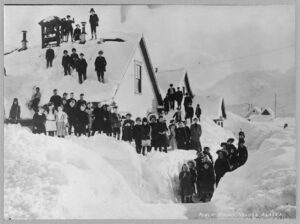
Frigid temps dragging you down? Let these classic winter weather photos from the Library of Congress archives make you feel glad to be living in the 21st century.
1. Shoveling inside your car
In 1917, the year that this photo was taken in New York City, automobiles were equipped with windshields but they did not yet have windows—you know, those pieces of glass above the doors of the car that keep stuff out. So snow removal was a back-breaking exterior and interior job.
2. No zamboni!
These boys, in an image snapped between 1909 and 1932, had to shovel the snow off the ice before skating on it, draining their energy and time. To sweep larger expanses, rink owners resorted to tractors dragging a scraper. After testing numerous prototypes, Frank J. Zamboni, high-school dropout and proprietor of Iceland Skating Rink in southern California, received a patent for his eponymous ice-cleaning machine in 1953.
3. No snow days
Two of the most beautiful words in the world: “snow day.” Most school districts in frosty climates have adapted through the years to have a certain number of snow days budgeted into their schedules so that learning stays on track. These Valdez, Alaska, students, shown here in 1910, did not have the luxury of staying home. But they did have the pretty cool perk of being able to stand on their schoolhouse roof.
4. Frigid beds
This photo shows a 1927 electric “blanketless bed” created by Milton Fairchild of Washington, D.C., a contraption that kept a person warm without the inconvenience of covers. It never caught on, probably because its target market—people who enjoy sleeping in a box—consisted of only the inventor himself.
5. Terrifying school transportation
Forget cars with seat warmers: Back in 1936, when this photo was taken, Minnesota students traveled to school in a cabin mounted on a sleigh. The trip took a bumpy two hours (one way) and that’s if their ride didn’t burst into flames first—the wooden compartment was heated by a stove.
6. Inadequate cold-weather gear
These days we gripe about being smothered, padded, and puffed up with all our layers of down and wool. Still, at least we can say we’re warm. Because unless her bonnet was lined with Gore-Tex, this girl (the first-place winner at a 1909 midwinter carnival in Upper Saranac, New York) was more suitably attired for a spring picnic than for a snowy stroll.
7. No fridges or freezers
Back in the day, if you wanted to eat different kinds of produce in the winter, it often came from a jar. Canning fruits and vegetables in glass jars—why wasn’t it called “jarring”?—was the cheapest, most reliable way to preserve them, but households ran the risk of their shelves collapsing from the heavy, breakable containers. Refrigerators and freezers were not common until after World War II, because the technology was faulty and prices were prohibitive. In 1939, when this photo was taken, a typical fridge cost around $240, or nearly $4,000 in today’s dollars.
8. Toiling in the brutal cold
These days, we can get the latest headlines just by scrolling through our phones—we don’t even need to leave our beds. And for those of us who prefer to read actual newspapers, we can pay someone to deliver it to our doorsteps. But until the Great Depression, newsies—boys who hawked newspapers on the streets for pennies a day—were the main way that the news was disseminated. In this 1909 photo taken in Hartford, Connecticut, the youngest newsie was 8, and he’d already been on the job for three years.




